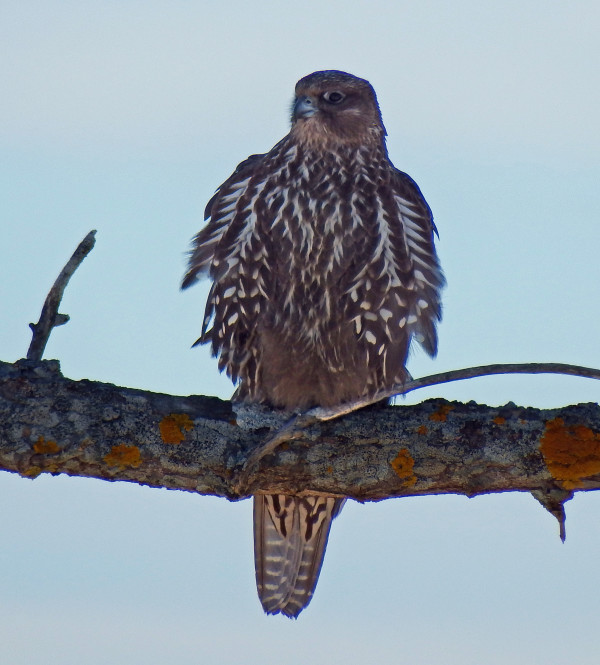
© Bob DuchesneGyrfalcon (dark morph)
We interrupt this column for a special announcement: "A gyrfalcon has appeared in Wells Harbor!"
The gyrfalcon is the largest falcon in the world, capable of taking down a Canada goose. It preys principally on ptarmigan, a chicken-like bird of the tundra, but it is so powerful that it is known to dine on other formidable raptors of the north, such as short-eared owls and rough-legged hawks.
It breeds in barren arctic regions around the world, but occasionally wanders southward in winter. It seldom stays long in one place.
My small group was on the prowl for snowy owls when we visited southern Maine last weekend. Several unusual birds also were known to be in the area, including a king eider in Ogunquit. The forecast was ideal, so down Interstate 95 we went. As we pulled into the public parking lot next to the harbor in Wells, a large hawk rested on the nearest tree - in fact, the only tree on the lot.
It was big. All eyes turned to me, the supposed expert. With no confidence in my voice at all, I announced my first impression that it was a red-tailed hawk. Then I put on my glasses and snickered at my folly. It was clearly a falcon, with strong shoulders, a short, narrowly tapered tail and a face mask typical of many falcon species. Peregrine falcon, I conceded.
It was big, too big. Furthermore, it just sat there, ignoring us. We were less than 100 feet away - about the length of a Tom Brady to Rob Gronkowski touchdown. I wondered why it was ignoring us.
And that is the power of why. As I wondered why it just sat there, the wheels in my head started turning. Peregrine falcons are bold, but not that bold. This bird should have been paying some attention to the humans milling about. There were dog walkers and beach combers using the lot, too. Most peregrines would have flown off to a quieter spot. This one didn't. Why?
Slowly, the truth dawned on me. It is a common trait among arctic breeding birds that they don't recognize humans as threats, since they rarely encounter humans at all. Unusual owls from the north, such as great gray, snowy and northern hawk-owls show little concern around people. Northern finches, such as crossbills, pine grosbeaks and redpolls, tolerate close approach. This does not give birders license to crowd tame birds. A birder's code of ethics obliges a respectful distance. But there were other people milling about, just as oblivious to the bird as it was to them. This falcon was acting relaxed, just like an arctic breeder.
I was aware that a gyrfalcon had been documented up the coast in Kennebunkport a few days earlier. I also was aware that it had not been witnessed for several days. On average, a gyrfalcon is seen in Maine maybe once a year, and only for a fleeting glimpse. They seldom linger. By this time, all of my group had sauntered off to look at other birds and search for snowy owls. I caught up to them and conveyed my growing suspicion. This was the gyrfalcon!
Eventually, it took flight, removing all doubt. Peregrine falcons are strong, acrobatic flyers. In pursuit, they gain altitude, swooping and diving on their victims. Gyrfalcons just muscle a direct flight path, straight as a cannonball, overtaking the fastest prey.
Gyrfalons are the size of a red-tailed hawk, and both are powerful, but this gyrfalcon left no doubt about who is master. Another birder captured video showing a red-tailed hawk that had strayed into the marsh and ventured too near a meal that this falcon was saving for later. The falcon left its perch and charged at the distant red-tail, forcing it to the ground. The red-tailed hawk rolled onto its back and raised its own formidable talents to fend off the assault, but that was as much as it could do against the faster, stronger bird. When granted a moment of relief, it flew off.
The gyrfalcon also flew off a couple of days later. At last report, it was terrorizing New Hampshire gulls.
Comment: See also: Rare Arctic gyrfalcon seen in Madbury, New Hampshire